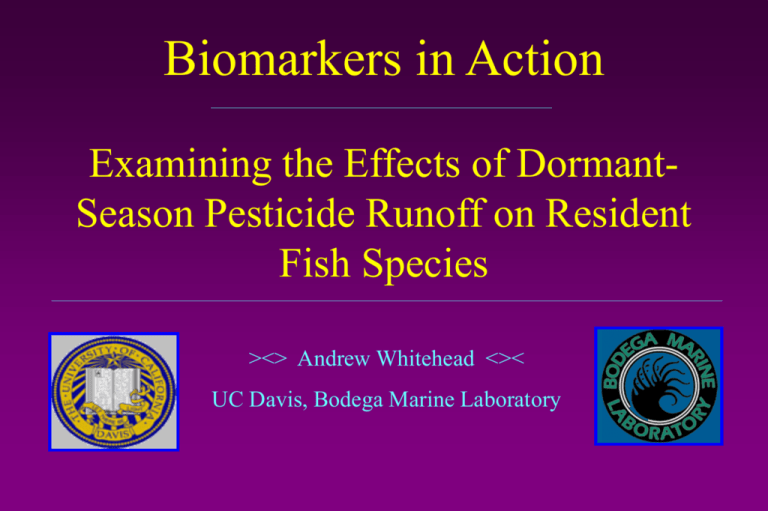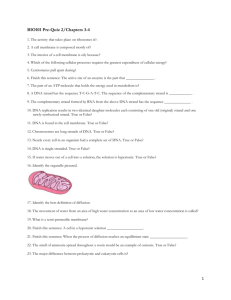SFEI_Talk_3-01-whitehead
advertisement

Biomarkers in Action Examining the Effects of DormantSeason Pesticide Runoff on Resident Fish Species ><> Andrew Whitehead <>< UC Davis, Bodega Marine Laboratory Talk Overview: Biomarkers: • Definition • Traits • Advantages / Strengths • Drawbacks / Difficulties Biomarkers in Action: Pesticides Project • Goals • Experimental Design • Data Biomarkers: Definition Physiological / biochemical response of an organism that is mechanistically / functionally related to xenobiotic exposure Principle: Xenobiotics interact with molecular targets through defined biochemical pathways which result in predictable physiological effects Definition (cont.) Biomarkers of Exposure: Biomarkers of Effect: - induction of accommodation responses • metallothionein induction • P450 induction • DNA adducts • heat shock protein induction • increase in plasma cortisol levels • induction of immune system • measurement of metabolites • serum leukocyte levels, antibody production - exposure has exceeded organism’s ability to accommodate • tissue necrosis • DNA mutations • AChE inhibition • developmental abnormalities • eggshell thinning • demasculinization, feminization • neoplasia, tumor formation Biomarkers: Traits • Variability • Sensitivity • Selectivity • Clarity of Interpretation • Biological Significance • Duration of Response • Ease of use, Cost, Labor Biomarkers vs. Other Approaches H2O Chemistry Monitoring: Unequivocal demonstration of presence/absence Snapshot in time/space, partitioning, exposure pathways, linkage to biological responses... Body Burden Analysis: Multiple exposure pathways Metabolism, sequestration Bioassays: Biological consequences Lab setting, standard test species Biomarkers: Advantages/Strengths • “So What?” • Linking Exposure to Effects • Integrated Information - Spatial - Temporal - Additive effects • Lab and Field experiments • Resident / Native organisms • Complex Field Evaluations: “Do Contaminants Play a Role?” Biomarkers: Drawbacks/Difficulties • Interpretation - Inferring causes - Scaling to meaningful effects - Timecourse of response • Understanding components of variation • Choice of biomarkers: What to measure? - Use tiered approach - Use other tools (chemistry) to focus choice Examining the Effects of DormantSeason Pesticide Runoff on Resident Fish Species PI: Dr. Susan Anderson – UC Davis, Bodega Marine Laboratory Coinvestigators: Dr. Bernie May – UC Davis Dr. Kathryn Kuivila – USGS Dr. David Hinton – Duke U Dr. Barry Wilson – UC Davis Graduate Student: Andrew Whitehead – UC Davis, Bodega Marine Laboratory Funding: EPA Star Grant, 1998 Project Goals: Overall: Examine biological effects of landscape-scale pesticide contamination on native fish at the individual and population levels. Characterize Exposure: • GIS mapping of pesticide use databases • Water chemistry Examine Effects on Individuals: • Acetylcholinesterase (AChE) inhibition assay • DNA strand break (comet) assay Examine Effects on Populations: • DNA fingerprinting / population genetic analysis using AFLP and microsatellites Experimental Design: Exposure Field-Caging Approach: • Cage suckers at 1 reference, 2 impacted sites • Retrieve cages at multiple timepoints, in order to: A) Capture pesticide peak B) Examine recovery time Environmentally realistic Risky, chance of catastrophe Water and sediment exposure Lab Exposure to Field-collected water approach: • collect field water in SS milk cans, transport to BML, expose fish - 6 d. Safe back-up Less environmentally realistic Can examine more sites Minimal sediment exposure Field Caging Design Cage 1 OUT 3 Cages IN River Flow Cage 2 OUT Cage 3 OUT Rain Rain 11 12 13 14 15 16 17 18 19 Date (February, 2000) 20 21 22 23 San Joaquin River @ Vernalis Orestimba Creek @ River Road Orestimba Creek @ Orestimba Road Lab Exposure Design • Composite samples collected in 35-L stainless steel milk cans • 6-day laboratory exposure to Sacramento sucker • Multiple tissues excised and archived for biomarker analysis (Brain, muscle, liver, gill, blood) Sites: • Feather R. upstream of ag. • Feather R. downstream • Orestimba Ck. upstream • Orestimba Ck. downstream • San Joaquin R. downstream • Laboratory control Experimental Design: Effects AChE Activity: • Indicator of exposure to and/or effects from specific class of xenobiotics with same mechanism of action = Organophosphate and carbamate pesticides DNA Strand Breaks: Comet Assay • Indicator of exposure to and/or effects from variety of stressors. = dormant-spray pesticides? Mutagenicity: Ames Assay Cytochrome P450 Activity DATA: AChE Activity - Field 300 San Joaquin R. 120 250 100 200 80 150 60 100 40 50 20 0 OP Pesticide Concentration (ng/L) Brain Acetylcholinesterase Activity (umol/min/g wet wt) 140 0 2/11/00 2/13/00 2/15/00 2/17/00 2/19/00 2/21/00 2/23/00 Date Sampled SJ AChE Activity OU AChE Activity (Ref) Diazinon + Methidathion Concentration DATA: AChE Activity - Lab 60 120 50 100 40 80 30 60 20 40 10 20 0 OP Pesticide Concentration (ng/L) Brain Acetylcholinesterase Activity (umol/min/g wet wt) 140 0 CON OU SJ FU FD Water Source AChE Activity Diazinon + Methidathion Concentration DATA: DNA Strand Breaks - Field 300 San Joaquin R. 50 250 40 200 30 150 20 100 10 50 0 0 2/11/00 2/13/00 2/15/00 2/17/00 2/19/00 2/21/00 Date Sampled SJ DNA Strand Breaks Diazinon + Methidathion Concentration OU DNA Strand Breaks (Ref) 2/23/00 OP Pesticide Concentration (ng/L) Index of DNA Strand Breaks (%DNA in Comet Tail) 60 50.0 200 45.0 180 40.0 160 35.0 140 30.0 120 25.0 100 20.0 80 15.0 60 10.0 40 5.0 20 0.0 0 OU OD OP Pesticide Concentration (ng/L) Index of DNA Strand Breaks (%DNA in Comet Tail) DATA: DNA Strand Breaks - Lab SJ Water Source DNA Strand Breaks Diazinon + Methidathion Concentration Summary: Project Suite of indicators, coupled with chemistry, has been a strong approach for assessing effects in the field, and in lab, on relevant species AChE Data: - As hypothesized, dormant-season pesticides are affecting resident fish - Would not have expected effects based on chemistry alone DNA Strand Break Data: - Indicates importance of chemicals other than pesticides Ongoing/Future Work: - Other indicators: Mutagenicity assay, P450 activity, more chemistry - Population genetic approach Overall Summary For simple problems, use simple tools Complex problems demand more sophisticated approaches Biomarker information • “So What?” • Focus - what are the real problems? • Integrated information • Relevant organisms • Field and lab evaluations A Day in the Life... 4X4? Catch anything? Speed, anyone? Hmm... Population-Level Biomarker Approach Working H: Long-term exposure to contaminants can alter gene pools of exposed populations. Rationale: Population genetic structure = historical record • Record of environmental influences on previous generations Challenges: • Distinguish natural variation from induced genetic change (field design) • Step from correlation to attribution (test for mechanisms) Hypotheses of Mechanisms that may Drive Pop’n Genetic Change: A) Natural Selection: Loss of sensitive individuals B) Mutation: Accumulation of rare mutations over generations C) Random Genetic Drift: Bottleneck Erosion of genetic diversity






